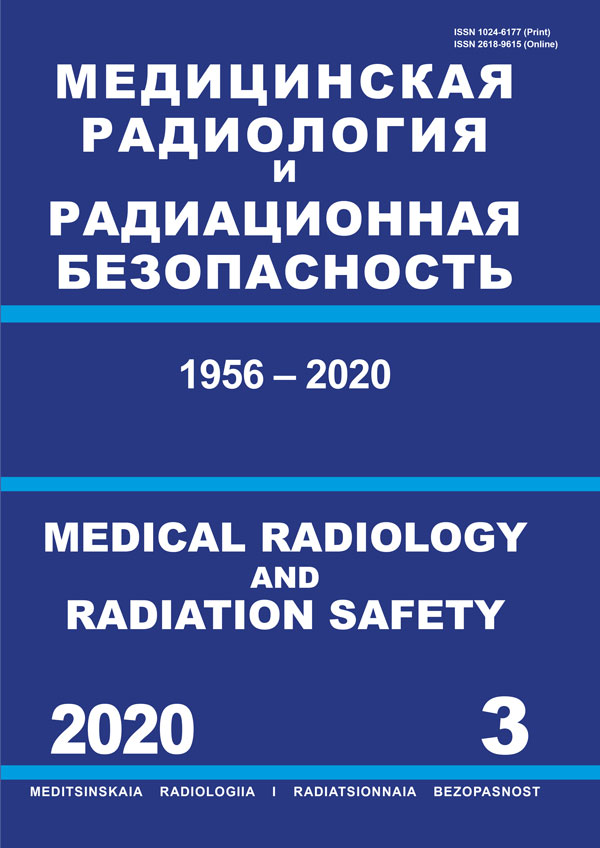Russian Federation
Chelyabinsk, Russian Federation
Russian Federation
CSCSTI 34.49
Purpose: Cerebrovascular disease (CVD) incidence and mortality rates were estimated in the cohort of nuclear workers occupationally exposed to radiation over a long period at the Mayak PA. Material and methods: Study cohort included 22377 workers (25 % females) of the Mayak Production Association employed during 1948–1982 and was based on “Clinic” medical dosimetry database and “Dosimetry system for Mayak workers 2008”. Statistica 6.0 software was used for statistical treatment and data analysis. Intensive (crude) and standardised incidence and mortality rates were calculated per 100 000 workers. Results: Number of cases and deaths from CVD were 8910 and 930 respectively. The greatest number of CVD cases (84 % of males and 87 % of females) was among workers of 50–69 years old, and the greatest number of CVD deaths (85 % of males and 94 % of females) was among workers of 60 years old and older. Conclusion: The present study showed that CVD incidence and mortality in the studied cohort of the Mayak nuclear workers occupationally exposed to radiation depended on the gender, age and calendar period. Statistically significant decreasing trends in CVD incidence and mortality over 1948–2013 period were not revealed.
cerebrovascular diseases, occupational exposure, Mayak PA
Цереброваскулярные заболевания (ЦВЗ) являются одной из важнейших медицинских и социальных проблем в большинстве экономически развитых стран, что обусловлено длительной утратой трудоспособности и высоким уровнем смертности. ЦВЗ наносят огромный ущерб экономике, учитывая расходы на лечение, медицинскую реабилитацию, потери в сфере производства. Ежегодно от ЦВЗ в России умирает около 300 тыс. человек. ЦВЗ являются второй по частоте причиной смерти, уступая лишь смерти от ишемической болезни сердца. Наряду с высокой смертностью нарушения мозгового кровообращения являются ведущей причиной стойкой нетрудоспособности у взрослых, обусловливая до 80 % частичной и до 10 % полной нетрудоспособности.
1. Denisova EV. Actual problems of the cerebral vascular diseases in the world (literature review). Bulletin of the Public Health and Health Protection of the Russian Far East. 2011;(3):1-5. Russian.
2. Demographic Yearbook of Russian. 2015: Stat. Coll. Rosstat. - M.: Rosstat, 2015. 263 p. Russian.
3. Alberts MJ. Ischemic stroke. Cerebrovascular Diseases. 2002;13(suppl. 1);12-16.
4. Stakhovskaya LV, Klochikhina OA, Bogatyryova MD, Kovalenko VV. Stroke epidemiology in Russia based on the territory population register (2009-2010). Journal of Neurology and Psychiatry. 2013;(5):4-10. Russian.
5. National Center for Health Statistics. Health, United States, 2015: With Special Feature on Racial and Ethnic Health Disparities. - Washington, DC: U.S. Government Printing Office, 2016. 461 p.
6. Kharchenko VI, Kakorina EP, Koryakin MV, et al. Circulatory disease mortality in Russia and economically developed countries. Necessity to strengthening of cardiological service and modernisation of the medical statistics in the Russian Federation. Analytical review of the Goscomstat official data, Ministry of Health Care and Social Development of the Russian Federation, WHO and expert estimates of the problem. Russian Cardiol Journal. 2005;(2):5-17. Russian.
7. Johnston SC, Mendis S, Mathers CD. Global variation in stroke burden and mortality: estimates from monitoring, surveillance, and modelling. Lancet Neurol. 2009;8(3):56-59.
8. Vishnevskiy A, Andreev E, Timonin S. Circulatory disease mortality and life span in Russia. Demographical Review. 2016;3(1):6-34. Russian.
9. Azizova TV, Bannikova MV, Moseeva MB, et al. Cerebrovascular diseases mortality in a cohort of workers occupationally exposed to radiation. Neurol Journal. 2016;21(4):226-231.
10. Azizova TV, Bannikova MV, Moseeva MB, et al. Cerebrovascular disease morbidity in a cohort of workers occupationally exposed to radiation. Journal of Neurology and Psychiatry. 2014;(12):128-132. Russian.
11. International classification of diseases of the 10th review (ICD-10). URL: http://www.mkb-10.com (access date: 07.03.2017).
12. Azizova TV, Teplyakov II, Grigoryeva ES, et al. «Clinic» medical dosimetry database for the Mayak workers and their families. Med Radiol and Radiation Safety. 2009;54(5):26-35. Russian.
13. Khokhryakov VV, Khokhryakov VF, Suslova KG, et al. Mayak Worker Dosimetry System 2008 (MWDS-2008): Assessment of internal alpha-dose from measurement results of plutonium activity in urine. Health Physics. 2013;104(4):366-378.
14. Merkov AM, Polyakov LE. Sanitary Statistics. Manual for Physicians. - Moscow. Atomizdat. 1975. 245 p.
15. Ahlbom A, Norell S. Introduction to Modern Epidemiology. - Stockholm, Sweden: Epidemiology Resources Inc, 1990. 109 p.
16. Lipovetskiy BM. Infarction, Stroke, Sudden Death. Risk Factors, Prodrome, Preventive Measures. - SPb.: Special literature. 1997. 191 p. Russian.
17. Gusev EI, Skvortsova VI, Stakhovskaya LV. Stroke epidemiology in Russia. Journal of Neurology and Psychiatry. («Stroke» appendum). 2003;(8):4-8. Russian.
18. Moseeva MB, Azizova TV, Grigoryeva ES, et al. Cerebrovascular disease mortality structure in a cohort of workers occupationally exposed to radiation over the follow-up period in dynamics. Ural Med Journal. 2017;5(149):114-120. Russian.





